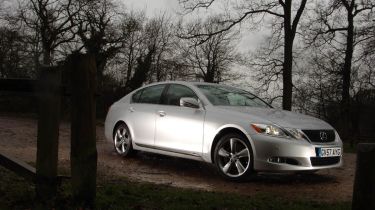Lexus
Japanese firm gives its GS a facelift and a bigger engine as it prepares to take on Jag XF.

Have these updates moved on the GS’s game enough? Not quite. It’s very capable and comfortable with a new engine that delivers incredible performance. And of course, the ownership experience will be painless – Lexus topped our 2007 Driver Power dealer satisfaction survey. But there are better all-round luxury models. Jaguar’s XF proves an executive car can look fantastic inside and out, drive brilliantly and come close to matching Lexus’s kit. If you must buy a GS, go for the hybrid, which costs less yet has better economy and performance.
There's no doubt that Jaguar’s XF is really stirring up the executive car market right now. With its striking looks, stunning interior and sporty driving experience, the spotlight is most definitely on the new big cat.
But what about the Lexus GS? Launched in 2005, it’s certainly proven a great improvement on its predecessor. Apart from the headline-grabbing hybrid version, though, other variants have been rather forgettable.
That’s why Toyota’s luxury arm has brought in a host of changes as part of a comprehensive facelift aimed at increasing its appeal.
And with replace-ments for the current BMW 5-Series and Mercedes E-Class due next year, the GS needs to be right on its game. So all models now get a chrome grille surround, revised door mirrors and reshaped bumpers. There are also new 17 and 18-inch alloys, plus extra paint shades.
It’s not exactly head-turning stuff and while the GS remains handsome, it’s visually uninspiring compared with the XF. Inside, flagship versions get higher-quality leather, revised steering wheel controls and even more wood trim around the gearlever.
The latter looks awful and despite the large touchscreen display, there are still too many buttons on the centre console. The controls really need to be simplified along the lines of Audi’s MMI system.
Fit and finish are both very good, though, and the seats supportive. Under the bonnet, the GS460 gets the same 4.6-litre V8 engine and eight-speed automatic transmission as the bigger LS. The motor produces 342bhp and 460Nm of torque, and the GS460 is capable of covering 0-60mph in 5.8 seconds. Top speed is electronically limited to 155mph.
Despite the two extra cogs, the gearbox is more compact and weighs less than the previous six-speed auto. So economy has improved by 2.7mpg – it’s now 27.5mpg on the combined cycle – and at 258g/km, CO2 emissions are 11g/km lower. Borrowing the hybrid’s stop-start system would improve those even more, though.
On the move, the GS460 is incredibly fast and impressively quiet. It can accelerate from 50mph to 70mph with supercar-like performance, and does so in near silence. The gearbox is slick, swapping its ratios almost imperceptibly. However, the steering is vague, and the car feels cumbersome on twisty roads. Potholes can upset the low-speed ride, with the body shimmying as a result.
What the GS460 is very good at, though, is cruising on the motorway. In this environment, it floats along majestically, insulating occupants from the outside world.
Yet at £50,500, it’s expensive. It’s well equipped, but the GS460 doesn’t feel as if it’s worth £5,000 more than a 4.2-litre V8-engined XF.







